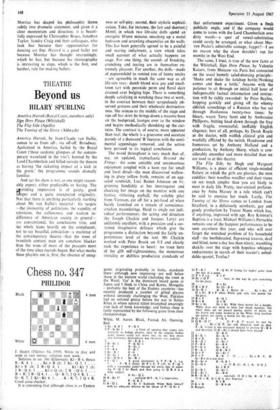Chess no. 347
PHILIDOR
Black White 4 men 6 men
J. Oudot (Themes 64, 1959). White to play and mate in two moves; solution next week.
Solution to no. 346 (Ellerman): Kt- B 6, threat R -K 4. I . . . Kt x B ch; 2 Kt- Q S. 1 . . Kt x R ch; 2 B-Q 4. 1. . . Kt-Kt 5 Ch; 2 B-Q 6. 1 ... Kt x Q ch; 2 8 -Q 6. I.
B x R; 2 B-Q 4. 1 ...Q-R 5; 2 Q x R. 1 ...
Q-K 7; 2 Kt-Kt 4. 1 K-K 7; 2 Q x R. Good cross-checker.
It is interesting that although chess is an EAstern game, originating probably in India, standards there—although now improving—are well below those in the western world (including the USSR in the West). 'Go' is the dominant board game in Japan and I think in China and Korea; Mongolia —probably the best of the Eastern countries—has recently produced a number of gifted players without seriously challenging the West; Pakistan had an isolated genius before the war in Sultan Khan in whom natural talent triumphed amazingly over lack of book knowledge; and Indian chess is fairly represented by the following game from their championships.
White, M. Aaron. Black, Farouk Ali. Opening, Reti.
Kt–K B 3 P–Q4
2 P – K Kt 3 . . . a form of opening that comes very naturally to Indian players, since in the original Indian game pawns could not move two oh the first move and fianchetto development was therefore very popular.
Kt – K B 3
3 i3-ki 2 P – K Kt 3 40-0 B – Kt 2
5 P – 11 4 P – B 3
6 Kt -B B 3 0 – 0
7 Q – Kt 3 P – Q 5 8 Kt – Q R 4 Kt – R 3
9 P – Q 3 A good alternative is 9 P – K 3, e.g. 9. . P – B 4 (best); 10 P X P. P X P; 11 P – Q 3 with a reasonable game—though his whble line of allow- ing P – Q 5 by Black and then going to Q R 4 is a little suspect.
9 . . . K Kt – Q 2 – 10 B Kt 5? . . and now 10 P – K 3! is imperative. 10 . . . P – K R 3 11 B – Q 2 R– Kt I! Suddenly White finds himself
with no adequate defence to the threat of P – Q Kt 4.
20 Q – Kt 4 P – K 4
21 Q R – Q 1? . . 21 P – K 3? would be met by
24 R – Q 2 25 P – B 4 26 P – K 4
27 R – K I
28 Q X P 21 . . .
22B – K 3 23 B x B
14 Kt x Q P . . best; in this way he gets something
1SBXRP Kt (2) – B 4
17 B x P B – Q 2 12 P – B 5 P – Q Kt 4! Going for higher game than
13 P X P e.p. P x P 14 . . . B x Kt 18 B X B Q X B
19 Kt x Kt Kt X Kt. With three pawns for a knight. 16 Q – R 3 R –K I. Better 16 . Kt X Kt; 17 Q x Kt; B X P when White gets only two pawns for for his piece.
his piece.
21 . . . Kt X (). P; the text threatens now to play the win of a pawn.
the pawns are rarely a match for the piece.
P – K 3—but it was necessary instead to prevent Q – R 6 and therefore 21 K – Kt 2 should have been played. White doe., not seem to have lost much material, but when there are no passed pawns, plenty of pieces on the board and some weakness in the White king position
Kt – B 4 Kt – K 6 Q – R 6! Kt – K 3! Kt x B Q R – B I! K – Kt 2 Kt – Kt 5 29PXP R – K 3 29 . Kt x R P; 30 Q – B 6 ch is less clear. 30 Q – Kt 4 R–K R I
31 Q – Q 4 . . or 31 R (1) – K 2. - Q B 3.
31 . . . Kt x R P 32 Q – B 2 Q – Kt 5 33 K – Kt 2 Kt – B 6!
34 R – K It 1 . . . naturally 34 Q x Kt. R – R 7 ch:
35 K x It, Q Q is also hopeless.
34 . . . RXR •
35-K x R Q–R 6 ch 36 Resigns.






























 Previous page
Previous page